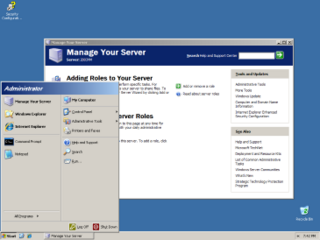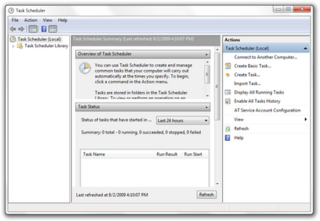Related Research Articles

In computing, multitasking is the concurrent execution of multiple tasks over a certain period of time. New tasks can interrupt already started ones before they finish, instead of waiting for them to end. As a result, a computer executes segments of multiple tasks in an interleaved manner, while the tasks share common processing resources such as central processing units (CPUs) and main memory. Multitasking automatically interrupts the running program, saving its state and loading the saved state of another program and transferring control to it. This "context switch" may be initiated at fixed time intervals, or the running program may be coded to signal to the supervisory software when it can be interrupted.

Microsoft Windows, commonly referred to as Windows, is a group of several proprietary graphical operating system families, all of which are developed and marketed by Microsoft. Each family caters to a certain sector of the computing industry. Active Microsoft Windows families include Windows NT and Windows IoT; these may encompass subfamilies, e.g. Windows Server or Windows Embedded Compact. Defunct Microsoft Windows families include Windows 9x, Windows Mobile and Windows Phone.
Computerized batch processing is the running of "jobs that can run without end user interaction, or can be scheduled to run as resources permit."

Non-Uniform Memory Access (NUMA) is a computer memory design used in multiprocessing, where the memory access time depends on the memory location relative to the processor. Under NUMA, a processor can access its own local memory faster than non-local memory. The benefits of NUMA are limited to particular workloads, notably on servers where the data is often associated strongly with certain tasks or users.

Windows 98 is an operating system developed by Microsoft as part of its Windows 9x family of Microsoft Windows operating systems. It is the successor to Windows 95, and was released to manufacturing on May 15, 1998, and generally to retail on June 25, 1998. Like its predecessor, it is a hybrid 16-bit and 32-bit monolithic product with the boot stage based on MS-DOS.

Windows Server 2003 is a server operating system produced by Microsoft and released on April 24, 2003, about 18 months after the launch of the Windows XP operating system. It is the successor to Windows 2000 Server and the predecessor to Windows Server 2008. An updated version, Windows Server 2003 R2, was released to manufacturing on December 6, 2005. Windows Server 2003's kernel was later adopted in the development of Windows Vista.

In computing, at is a command in Unix-like operating systems, Microsoft Windows, and ReactOS used to schedule commands to be executed once, at a particular time in the future.
In computing, scheduling is the method by which work is assigned to resources that complete the work. The work may be virtual computation elements such as threads, processes or data flows, which are in turn scheduled onto hardware resources such as processors, network links or expansion cards.

Windows Vista is an operating system produced by Microsoft as a member of the Windows NT family of operating systems for use on personal computers. Development was completed on November 8, 2006, and over the following three months, it was released in stages to computer hardware and software manufacturers, business customers and retail channels. On January 30, 2007, it was released worldwide and was made available for purchase and download from the Windows Marketplace; it is the first release of Windows to be made available through a digital distribution platform. The release of Windows Vista came more than five years after the introduction of its predecessor, Windows XP, the longest time span between successive releases of Microsoft Windows desktop operating systems.

Mark Eugene Russinovich is a Spanish-born American software engineer who serves as CTO of Microsoft Azure. He was a cofounder of software producers Winternals before it was acquired by Microsoft in 2006.
The Windows System Assessment Tool (WinSAT) is a module of Microsoft Windows Vista, Windows 7, Windows 8 and Windows 10 that is available in the Control Panel under Performance Information and Tools. It measures various performance characteristics and capabilities of the hardware it is running on and reports them as a Windows Experience Index (WEI) score. The WEI includes five subscores: processor, memory, 2D graphics, 3D graphics, and disk; the basescore is equal to the lowest of the subscores and is not an average of the subscores. WinSAT reports WEI scores on a scale from 1.0 to 5.9 for Windows Vista, 7.9 for Windows 7, and 9.9 for Windows 8 and Windows 10.

ReadyBoost is a disk caching software component developed by Microsoft for Windows Vista and included in later versions of the Windows operating system. ReadyBoost enables NAND memory mass storage devices, including CompactFlash, SD cards, and USB flash drives, to be used as a cache between a hard drive and random access memory in an effort to increase computing performance. ReadyBoost relies on the SuperFetch technology and, like SuperFetch, adjusts its cache based on user activity. Other features, including ReadyDrive, are implemented in a manner similar to ReadyBoost.
Apache Hadoop is a collection of open-source software utilities that facilitate using a network of many computers to solve problems involving massive amounts of data and computation. It provides a software framework for distributed storage and processing of big data using the MapReduce programming model. Hadoop was originally designed for computer clusters built from commodity hardware, which is still the common use. It has since also found use on clusters of higher-end hardware. All the modules in Hadoop are designed with a fundamental assumption that hardware failures are common occurrences and should be automatically handled by the framework.
Windows Vista introduced a number of new I/O functions to the Microsoft Windows line of operating systems. They are intended to shorten the time taken to boot the system, improve the responsiveness of the system, and improve the reliability of data storage.

Microsoft Drive Optimizer is a utility in Microsoft Windows designed to increase data access speed by rearranging files stored on a disk to occupy contiguous storage locations, a technique called defragmentation. Defragmenting a disk minimizes head travel, which reduces the time it takes to read files from and write files to the disk. As a result of the decreased read and write times, Microsoft Drive Optimizer decreases system startup times for systems starting from magnetic storage devices such as a hard drive. However, defragmentation cannot be run on storage devices such as solid state drives, USB drives or SD cards that use flash memory to increase speeds, as these drives do not use a head. Defragmentation may decrease lifespan for certain technologies, e.g. solid state drives. Microsoft Drive Optimizer was first officially shipped with Windows XP.
Windows Vista, an operating system released by Microsoft for consumers on January 30, 2007, has been widely criticized by reviewers and users. Due to issues with new security features, performance, driver support and product activation, Windows Vista has been the subject of a number of negative assessments by various groups.

Performance Monitor is a system monitoring program introduced in Windows NT 3.1. It monitors various activities on a computer such as CPU or memory usage. This type of application may be used to determine the cause of problems on a local or remote computer by measuring the performance of hardware, software services, and applications.
Windows Vista contains a range of new technologies and features that are intended to help network administrators and power users better manage their systems. Notable changes include a complete replacement of the "Windows Setup" process, completely rewritten deployment mechanisms, support for per-application Remote Desktop sessions, new diagnostic and health monitoring tools, and a range of new Group Policy settings covering many of the features new to Windows Vista.

Task Scheduler is a component of Microsoft Windows that provides the ability to schedule the launch of programs or scripts at pre-defined times or after specified time intervals: job scheduling. It was first introduced in the Microsoft Plus! for Windows 95 as System Agent but was renamed to Task Scheduler in Internet Explorer 4.0 and Windows 98. The Windows Event Log service must be running before the Task Scheduler starts up.
cgroups is a Linux kernel feature that limits, accounts for, and isolates the resource usage of a collection of processes.
References
- ↑ Michael Aldridge; Josh Evitt; Lisa Donald & James Chellis (2007). MCTS: Microsoft Windows Vista Client Configuration Study Guide. John Wiley & Sons. p. 534. Retrieved March 31, 2014.
- ↑ Marco Chiappetta (September 8, 2011). "How to Max Out Your Windows Performance for $1000". PC World . Retrieved March 31, 2014.
- ↑ Eitan Frachtenberg & Uwe Schwiegelshohn (2007). Job Scheduling Strategies for Parallel Processing: 12th International Workshop, JSSPP 2006, Saint-Malo, France, June 26, 2006, Revised Selected Papers. Springer. p. 202. Retrieved March 31, 2014.